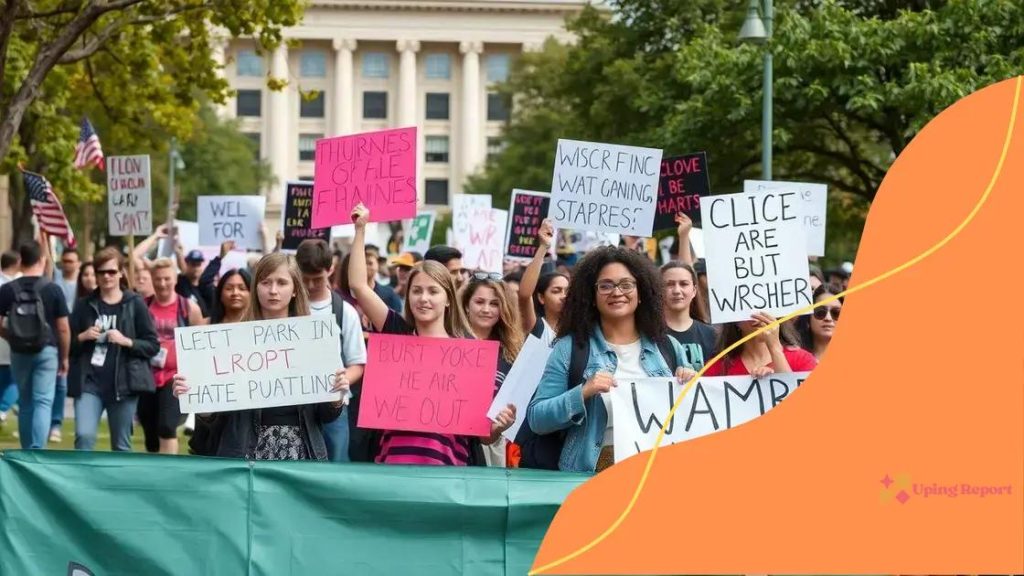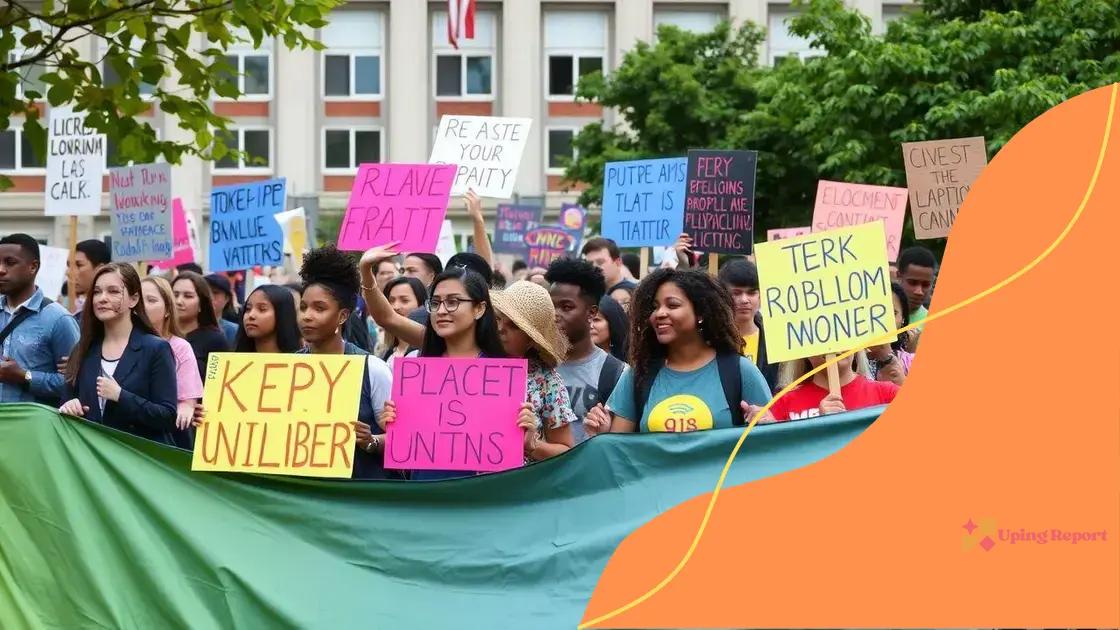Protests over campus activism crackdowns raise concerns

Protests over campus activism crackdowns highlight the struggles students face in voicing their concerns and the need for supportive environments to foster open dialogue and engagement.
Protests over campus activism crackdowns are taking center stage as students voice their concerns. What does this mean for the future of free expression on campuses? Let’s dive in.
Understanding campus activism
Understanding campus activism is essential in today’s educational environment. It reflects the changing views of students and their desire for a voice. Many students engage in activism to pave the way for meaningful changes in their institutions and society.
What is Campus Activism?
Campus activism refers to the efforts of students to bring about social, political, or cultural change within their educational institutions. These movements often tackle issues like diversity, equality, and freedom of expression. As awareness grows, the methods of activism also evolve to adapt to new challenges.
Common Goals of Student Activism
- Advocacy for social justice: Many student activists focus on equality and fight against discrimination.
- Increased awareness of mental health: Students push for better mental health resources and support on campus.
- Environmental sustainability: Many movements advocate for eco-friendly policies and practices.
- Free speech rights: Students often rally for the right to express their views freely.
Moreover, campus activism fosters a sense of community and belonging among students. It encourages them to connect with like-minded individuals who share similar goals and aspirations. Through organizing events, creating awareness campaigns, or debating complex issues, students learn valuable skills.
The Impact of Technology on Activism
Technology plays a significant role in student activism today. Social media platforms allow students to spread their messages quickly, gather support, and create movements that resonate widely. Online petitions, hashtags, and virtual events have become common tools for raising awareness. This digital age enhances the reach of activism, enabling students to mobilize in unprecedented ways.
Understanding campus activism is more than just observing protests; it’s about recognizing the passion students have for creating change. As we explore this topic, we see how activism shapes the college experience and prepares students for future engagement in society.
The impact of crackdowns on student engagement
The impact of crackdowns on student engagement is significant and often troubling. As universities tighten restrictions on activism, many students feel their voices are stifled. This repression can reduce participation and create a climate of fear among those who wish to speak out.
Effects on Student Activism
When crackdowns occur, students may hesitate to engage in activism. They worry about potential repercussions, such as disciplinary actions or loss of privileges. These fears can lead to a decrease in organized events and protests, which are vital for sharing ideas and mobilizing support.
Key Consequences of Crackdowns
- Reduced participation: Many students withdraw from activism to avoid confrontations with authorities.
- Chilled speech: Students might hesitate to express their views openly, fearing backlash.
- Disconnect from campus life: A lack of engagement can alienate students from their peers and the broader community.
- Diminished dialogue: Open discussions on important issues may decline, limiting diverse perspectives.
The repression of activism does not just affect those involved directly. It can create an atmosphere where debate and critical thought are suppressed. This situation may lead to frustrated students who feel isolated and unsupported. Young people often crave connection and community, which activism provides. Denying them this opportunity can have long-term effects on their civic engagement.
Long-Term Impact on Engagement
As students witness these crackdowns, they may disengage altogether from university life. This disengagement can result in lower attendance at events, reduced participation in student government, and a lack of involvement in clubs. Furthermore, the lessons learned in these formative years shape their future engagement in society.
Ultimately, understanding the impact of crackdowns on student engagement is crucial for fostering an environment that encourages active participation. Universities must balance maintaining order with allowing students the freedom to express their beliefs and advocate for change.
Key protests and movements

Key protests and movements shape the landscape of campus activism. Students rally for various causes, responding to social injustices and issues affecting their education and community. Understanding these movements helps us appreciate their significance in promoting change.
Notable Protests in Recent Years
Several key protests have gained national attention. Movements such as the Black Lives Matter campaign have inspired students to advocate for racial equality on campuses. In addition, students have organized walkouts and demonstrations against sexual assault and mental health stigma.
Examples of Student Movements
- March for Our Lives: Initiated by students after school shootings, advocating for gun control and safety.
- #MeToo Movement: Empowered students to speak out against sexual harassment and assault in educational settings.
- Climate Strikes: Students demand action on climate change, urging institutions to adopt sustainability practices.
- Immigration Activism: Protests focused on advocating for the rights of undocumented students and broader immigration reform.
These movements illustrate the power students have when they unite for a common cause. Each protest not only brings attention to important issues but also mobilizes fellow students to engage in meaningful dialogue. The impact of these actions extends beyond campus borders, affecting local communities and even national policies.
The Role of Social Media
Social media plays an essential role in organizing and amplifying these protests. Platforms like Twitter and Instagram allow students to share their messages widely and quickly. Hashtags help to consolidate efforts and bring attention to critical issues. As a result, online activism complements traditional methods, such as rallies and petitions, enhancing the reach and effectiveness of student movements.
Understanding the key protests and movements is vital not only for recognizing student voices but also for fostering a culture of engagement. Each action taken by students helps pave the way for future generations to advocate for their beliefs with confidence and determination.
Student perspectives on activism repression
Student perspectives on activism repression shed light on the challenges faced when voicing their concerns. Many students feel that repressive measures create a culture of silence. This can discourage them from advocating for changes they are passionate about.
Feeling Targeted and Vulnerable
When students face crackdowns, they often feel targeted by their administrations. Many express fear of disciplinary actions for simply speaking out. This fear can deter them from participating in protests or discussions about essential issues. The feeling of vulnerability leads to anxiety about their futures, making it harder for them to express their thoughts.
Examples of Student Experiences
- Fear of Disciplinary Action: Students often worry about being punished for their activism, which can stop them from speaking out.
- Loss of Community: Many students feel isolated when their peers withdraw from activism to avoid repercussions.
- Frustration with Administration: Students can feel frustrated when their schools don’t support their right to protest.
- Desire for Genuine Dialogue: There is a strong wish among students for open conversations about pressing issues.
Students are eager to share their perspectives and demand respect for their rights. They believe that open dialogue is essential for progress. However, when repression occurs, their voices become muted. The need for a supportive environment is clear; students desire a space where they can express their views and engage in healthy discussions.
Strategies for Resilience
In response to feelings of repression, many students develop strategies to cope and advocate for their rights. Collaborating with supportive organizations can provide students with the resources they need to navigate challenges. Building coalitions with other groups amplifies their voices, making it easier to address issues collectively. Using online platforms allows them to communicate more freely, sharing their concerns and rallying support from others.
Understanding student perspectives on activism repression can help schools create better policies that respect students’ rights. By fostering an environment where students feel safe to express themselves, universities can encourage future generations to engage in activism without fear.
Future of activism in educational institutions
The future of activism in educational institutions looks promising, as students continue to find new ways to express their voices. With the rise of technology and social media, students are more empowered than ever to advocate for change. This evolving landscape suggests a continued focus on critical issues that matter to them.
Emergence of New Causes
As young people become more aware of global issues, new causes are emerging on campuses. Topics like climate change, mental health awareness, and social justice are gaining traction. Students are not only passionate about these issues but also eager to enact change within their schools and communities.
Tools for Mobilization
- Social Media: Platforms such as Instagram and Twitter allow students to quickly share information and organize events.
- Virtual Events: Online meetings and webinars create opportunities for broader participation, even from those who cannot attend in person.
- Collaboration with Organizations: Partnering with local and national organizations can amplify student efforts and provide resources.
- Creative Campaigns: Art and music can be effective ways to spread messages and inspire action among peers.
Students are leveraging these tools to expand their reach and influence. They understand that to create lasting change, they need to communicate their messages effectively and engage those around them. The use of innovative strategies helps keep activism vibrant and relevant.
Challenges Ahead
Despite the positive outlook, challenges remain for activism in educational institutions. Increasing restrictions from administrations can stifle student voices. Additionally, the fatigue of continuous activism can affect engagement levels. However, resilient students find ways to overcome these obstacles. They adapt to new environments and work collectively to ensure their voices are heard.
The trajectory of activism points towards a future where student engagement remains essential. Educational institutions must recognize and support these movements, fostering a climate that encourages open dialogue and action. The empowerment of students today will shape the leaders of tomorrow, making their success crucial for a better society.
FAQ – Frequently Asked Questions about Campus Activism
How can students effectively organize protests on campus?
Students can effectively organize protests by using social media to spread the word, collaborating with student organizations, and planning events in advance to ensure maximum participation.
What are some common challenges students face in activism?
Common challenges include fear of disciplinary action from university administrations, feeling isolated from peers, and the potential for burnout from continuous activism.
How does technology impact student activism today?
Technology enhances student activism by allowing for faster communication, the ability to mobilize supporters quickly, and creating online platforms for sharing ideas and resources.
What role do educational institutions play in supporting student activism?
Educational institutions can support student activism by providing safe spaces for dialogue, protecting students’ rights to protest, and engaging with student concerns to foster a positive environment for activism.
